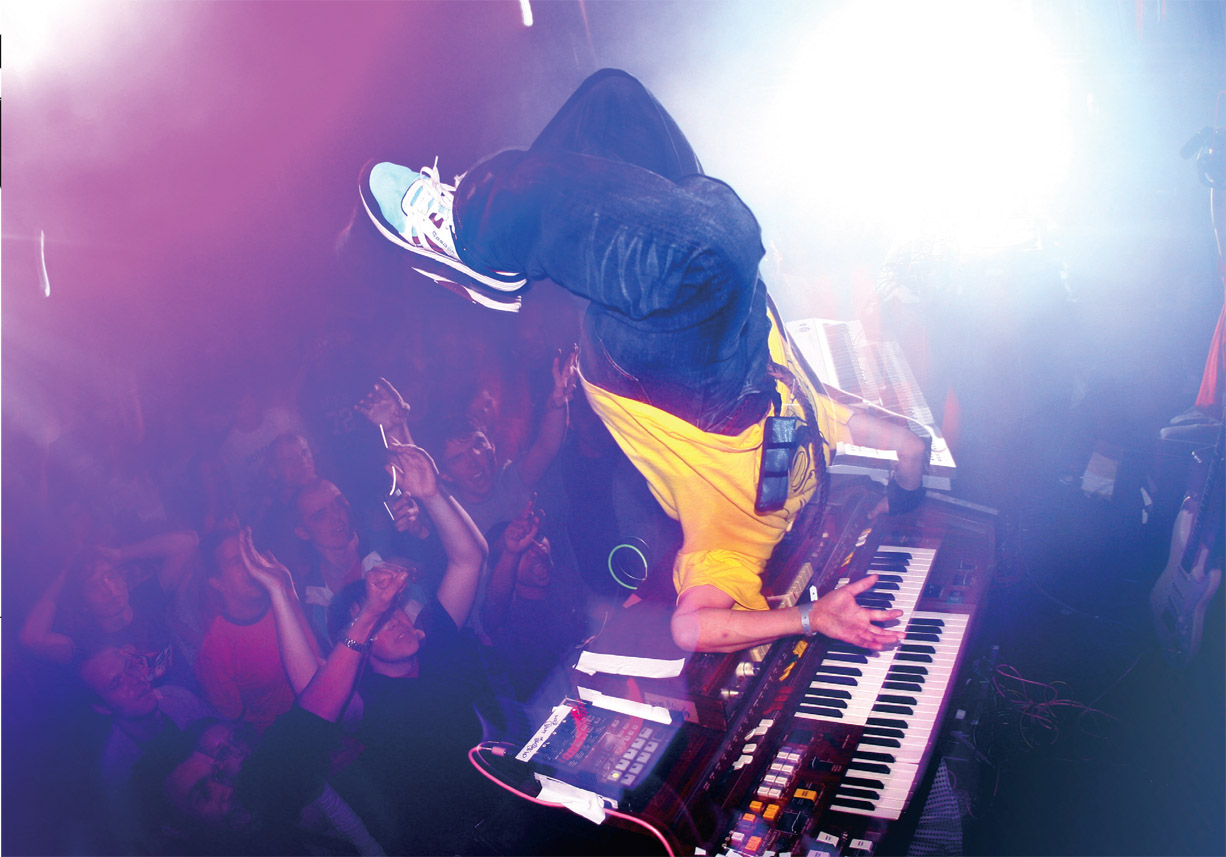Tucker started his musical education playing guitar. “When I was a high school student, I went to a school that taught theory of jazz for about two years,” he says, “but because studying theory is boring, I was always doing impromptu guitar sessions with my teacher and friends. I think that was helpful. I never studied the piano or organ formally, but when I was still working for a company, I practiced organ everyday after the work.”
The organ was an ideal instrument for Tucker’s boundless energy and sense of showmanship. The electric organ is an inherently theatrical live instrument, requiring its player to move rapidly between two keyboards, two or more sets of foot pedals, and an additional lever usually operated by the performer’s knee. A dynamic Electone player appears to be simultaneously dancing and playing, and that’s before adding the other equipment that makes up live sets. Tucker’s sets are a full-body experience and an impressive display of musical savvy and athletic prowess.
Tucker’s music defies easy categorization, but many of his supporters are part of the broader Japanese hip hop (or J-hop) movement. The history of hip hop in Japan is long and controversial, a microcosm for issues of authenticity and globalization.
Ian Condry, an assistant professor of Japanese cultural studies at MIT, maintains a comprehensive website devoted to the history of Japanese hip hop. One of his frequently asked questions is, “Isn’t it just imitation?” — a question leveled at all non-African American hip hop performers, and one that is particularly sensitive in Japan, where the small ganguro (or “blackface”) movement has received an outsized amount of media attention.
J-hop began with dance, an instantly captivating art form that arrived without rap’s linguistic difficulties in the early 1980s in Tokyo. Graffiti, deejaying, and rap followed, though the Japanese language is not well suited to conventional American-style rap. As early as 1986, Tokyo’s Shibuya district had its own hip hop club and with it a tradition of music, dance, visual arts, and fashion. The nightclub district became known as the genba, or localized site, of a specifically Japanese movement.
In essays such as “Japanese Hip-Hop and the Globalization of Popular Culture” from the book Urban Life, Condry tackles the “legitimacy” of Japanese hip hop by locating the emergence of the J-hop market as a confluence of global media and local creativity. As the home-grown hip hop movement developed, Japanese artists found their voice and began addressing specifically Japanese concerns, replacing an American focus on weapons and violence with a criticism of the Japanese work ethic, social conformity, and education system. Where violence (either literal or metaphorical, as in DJ “battles”) appeared, it was often represented in the guise of the Japanese samurai.
Yet debates on whether Japanese (or any international) hip hop is “real” seem beside the point when artists like Tucker continue to break boundaries of genre, geography, and decade.
Down-to-earth Tucker is a little taken aback when asked what makes Japanese hip hop unique.
“Because I am Japanese,” he says, “I am not sure what is unique about Japanese hip hop. But I think it is interesting that many Japanese rappers are singing about something [that they] relate to themselves these days. People realized it was not always necessary to perform like the original [African-American] rap performers. I think their performance became unique and more interesting.”
Tucker’s playfulness, his willingness to appropriate what he chooses from punk, ska, heavy metal, and even “Sesame Street” points to the success of this unique approach. His “retro-Vaudeville” style is boundlessly allusive and energetic. His growing global fan base is thanks in large part to the democratizing borderlessness of YouTube, which broadcasts little girls’ organ concerts to international applause. And though the Yamaha Electone is currently unavailable for export to the west, that doesn’t stop US and European collectors from scheming to import them — but at $2,000 a pop, it’s unlikely that anyone will be setting them on fire.

